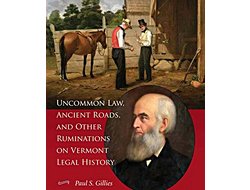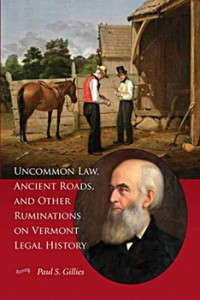
 Uncommon Law, Ancient Roads, and other Ruminations on Vermont Legal History, by Paul Gillies. Published by the Vermont Historical Society. 2013. 414 pages with index. $24.95.
Uncommon Law, Ancient Roads, and other Ruminations on Vermont Legal History, by Paul Gillies. Published by the Vermont Historical Society. 2013. 414 pages with index. $24.95.
Reviewed by Paul Lefebvre
People who major in history in college often find themselves going to law school once they graduate. More often, anyway, than those who major in physics or biology. Ironically, Paul Gillies, who has a master’s degree in English from the University of Vermont, reversed that familiar transition by becoming a historian after he first became a lawyer.
Fortunately, for anyone interested in Vermont history, it’s been a seamless transition. As a lawyer with a flair for writing, Gillies has given us a book that is quirky, original and highly entertaining as a study of Vermont’s past.
What’s original about Uncommon Law, Ancient Roads and Other Ruminations on Vermont Legal History, is how revealing our laws reflects our history. Not just the laws as they were passed 200 years ago, but as recent as the Ancient Road Law that was passed by the Legislature in 2006.
The key question underlying ancient roads, say Gillies, writing as an attorney, is: “What happens when the town announces it intends to develop the public road that runs through your property that nobody has traveled for several centuries?”
The question requires a legal resolution, but Gillies the historian frames its importance in a much larger context. The lasting value in finding ancient roads — those having “no nexus to the current highway map” — is to show how a town evolved, or “how the hill farms were abandoned, the villages developed, and the land subdivided.”
Politically, a republic is a country governed by laws. And to read Gillies is to see how laws mirror a country or state’s historical development.
Following the American Revolution, the country as well as Vermont did away with the British custom of judges wearing scarlet and ermine robes in court. The tradition of judges wearing robes, however, remained.
By wearing a robe, explains Gillies, “the person is covered up and the office made manifest by the costume.” And while individual judges may retire, “the robe comes back every day.”
Not to be outdone by members of the judicial branch, Vermont legislators even went one step further in 1789 by allowing members to “sit with their heads covered, except when they address the Speaker.”
Gillies, himself, appears to have little patience with some of the practices still at work today when a Latin phrase is used instead of an English one. For while it may elevate a proceeding, he says, it also has a downside for the layman who has come to court.
“Latin can be so powerful, until you have to translate it, and then it falls flat, like explaining a joke to someone who doesn’t get it.”
Property laws or those regulating trade and commerce often come in reaction to something that is causing a conflict. Gillies lays out an number of case histories on point, including those stemming from an eighteenth-century enterprise that every spring churned the waters of the Connecticut River until the early nineteen-hundreds: the log drives.
“Like the law, log driving took balance, judgment, and quickness,” he writes in verve that is typical of his style.
In 1785 the Legislature passed a law that gave an owner nine months to remove his logs from a drive that had become snared by the river. Similar laws ruled that the logs could be no longer than 20 feet and had to be marked for identification by the owner.
Throughout the decades there were laws passed that regulated log diameters and set deadlines for driving logs from one point to another.
“The present law is a museum of regulations of the log driving industry,” write Gillies. And they still remain on the books.
Selectmen determine the location of the boom in rivers and streams to hold back the logs, “and no boom may be anchored until the fees are paid,” Gillies writes.
“Should log drives come back, the law awaits them.”
Packed into this big book — which can easily be read as an anthology — is a chapter on what Gillies understandably calls “Luminaries,” former Supreme Court Justices. As profiles they run the gambit from Nathaniel Chipman — who in 1786 at 33 years old was elected to serve on the Supreme Court — to Justice F. Ray Keyser, who joined the Court in 1964.
Justice Chipman was Vermont’s foremost legal scholar, but what he contributed to the state’s legal foundation is, in Gillies’ view, the lynchpin to what we have become today as a society.
In his Sketches of the Principles of Government, written in 1793, Justice Chipman took a very benign and, at the time, radical view of human nature. People do not need a government to protect themselves from each other, because they have a natural “relish for society.”
In other words, writes Gillies, “human beings in Chipman’s view were drawn intuitively to society, order, and organization as a fulfillment of their quest for happiness and social improvement.”
Among his peers, Gillies says, Chipman was a lawyer who liked to play in deep waters but had difficulty when it came to sustaining a lawyer-client relationship.
The profiles make up a hefty third of the book, which may explain why Gillies offered a writer’s disclaimer before forging ahead.
“Each essay is a violation against the law of practicing psychology without a license, but the perfume of the temptation is irresistible against the possible odor of the risk,” he writes.
Gillies concluded his book with a lengthy examination of Act 250, whose significance for Vermont he underscores by writing:
“In 1969, there was Woodstock, Vietnam, the moon landing, the Manson murders, and Act 250.”
He credits Governor Deane Davis for seeing the need and the 1970 Legislature for following through to pursue “a public interest in traditionally private matters when it comes to land and how it is used.”
Gillies says that Act 250 has reached maturity, and traces its evolution over four decades. The results over the first ten years were mixed, or constitute what the author calls a difficult childhood. By 1980, he says the Act “had found its bearings,” after the Legislature eliminated the “ten-acre loophole,” which took away lot size as an exemption from Act 250 review.
The third decade, “its most difficult,” saw wrangles with the Legislature over membership on the Environmental Board. An Environmental Court was created. Accusations proliferated that the Act 250 process was too unwieldy. Gillies called it a time for retrenchment.
Throughout its fourth decade, which began in 2000, Act 250’s power to regulate was diminished by the Legislature and the High Court, according to Gillies.
Speaking of the Act as a process, the author writes: “It has been revised almost as often as educational theory. What other law has had to be saved so often?”
As a lawyer, Gillies has made his mark by representing towns. Before ancient roads became such a hot political issue, he may have been municipal government’s first road warrior. To that end, he is also the first historian to study the state’s past by looking at its routes of travel.
“The developing road network is a revelation of several centuries of community evolution,” he writes.
“This is the beginning of the golden age of Vermont highway law.”
contact Paul Lefebvre at [email protected]
For more free articles from the Chronicle like this one, see our Reviews pages. For all the Chronicle’s stories, pick up a print copy or subscribe, either for print or digital editions.







